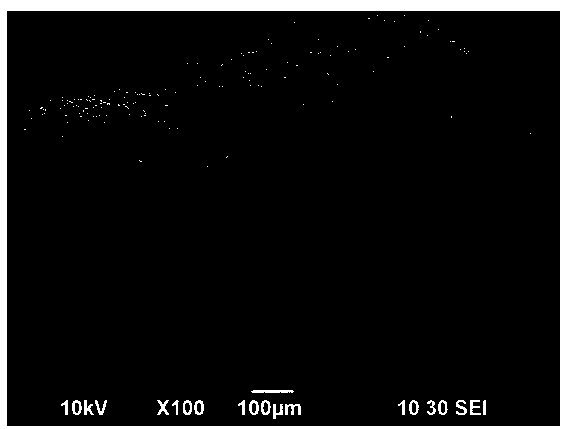A kind of photocatalyst ceramsite of loading modified tio2 and preparation method thereof
A photocatalytic and modification technology, applied in the field of photocatalytic materials, can solve the problems of limited solar energy utilization and high price, and achieve the effects of high catalytic degradation ability, uniform particle size, and cheap raw materials
- Summary
- Abstract
- Description
- Claims
- Application Information
AI Technical Summary
Problems solved by technology
Method used
Image
Examples
Embodiment 1
[0030] (1) Take 40 parts of sludge, 40 parts of kaolin, 15 parts of sawdust, and 10 parts of calcium hydroxide, all in parts by weight. The above-mentioned raw materials are fully mixed and stirred to be prepared into mud, and the mud is made into rod-shaped particles with a diameter of 2 mm using a granulator, and dried to form a billet;
[0031] (2) Place the mud billet obtained in step (1) in a high-temperature sintering furnace, heat up at 80°C per hour to 550°C, hold for 2 hours, and then continue to heat up at a heating rate of 100°C per hour until 1000°C , keep the temperature for 3 hours, stop heating, and reduce the furnace temperature to room temperature at a rate of 150°C per hour to obtain porous ceramsite for use.
[0032] (3) According to Ti:N:S=1:4:4 (molar ratio), weigh 3.6596g of butyl titanate, 1.2913g of urea, and 3.2742g of thiourea. Dissolve urea and thiourea in 75 mL of ethanol solution adjusted to pH=2 with hydrochloric acid, denoted as A. The butyl ti...
Embodiment 2
[0035] (1) Take 50 parts of sludge, 30 parts of bentonite, 10 parts of activated carbon, and 15 parts of calcium hydroxide, all in parts by weight. The above-mentioned raw materials are fully mixed and stirred to be prepared into mud, and the mud is made into rod-shaped particles with a diameter of 4 mm using a granulator, and dried to form a billet;
[0036] (2) Place the mud billet prepared in step (1) in a high-temperature sintering furnace, heat it up at 80°C per hour to 600°C, hold it for 2 hours, and then continue to heat up at a heating rate of 100°C per hour until it reaches 1100°C , keep the temperature for 2.5 hours, stop heating, and reduce the furnace temperature to room temperature at a rate of 200° C. per hour to obtain porous ceramsite for use.
[0037](3) Weigh 3.6596g of butyl titanate, 0.9685g of urea, and 2.4557g of thiourea according to Ti:N:S=1:3:3 (molar ratio). Dissolve urea and thiourea in 56 mL of ethanol solution adjusted to pH=2 with hydrochloric ac...
Embodiment 3
[0040] (1) Take 30 parts of sludge, 50 parts of activated clay, 20 parts of sawdust, and 10 parts of calcium hydroxide, all in parts by weight. Fully mix and stir the above raw materials to make slurry, use a granulator to make the slurry into spherical particles with a diameter of 6mm, and dry it to form a billet;
[0041] (2) Put the mud body prepared in step (1) in a high-temperature sintering furnace, heat it up to 550°C at 100°C per hour, keep it warm for 2 hours, and then continue to heat up at a rate of 100°C per hour until it reaches 900°C , kept warm for 3 hours, stopped heating, and lowered the furnace temperature to room temperature at a rate of 150° C. per hour to obtain porous ceramsite for later use.
[0042] (3) Weigh 3.6596g of butyl titanate, 1.6141g of urea, and 4.0928g of thiourea according to Ti:N:S=1:5:5 (molar ratio). Dissolve urea and thiourea in 94 mL of ethanol solution adjusted to pH=2 with hydrochloric acid, and record it as A. Dissolve butyl titan...
PUM
| Property | Measurement | Unit |
|---|---|---|
| diameter | aaaaa | aaaaa |
| diameter | aaaaa | aaaaa |
| diameter | aaaaa | aaaaa |
Abstract
Description
Claims
Application Information
 Login to View More
Login to View More - R&D
- Intellectual Property
- Life Sciences
- Materials
- Tech Scout
- Unparalleled Data Quality
- Higher Quality Content
- 60% Fewer Hallucinations
Browse by: Latest US Patents, China's latest patents, Technical Efficacy Thesaurus, Application Domain, Technology Topic, Popular Technical Reports.
© 2025 PatSnap. All rights reserved.Legal|Privacy policy|Modern Slavery Act Transparency Statement|Sitemap|About US| Contact US: help@patsnap.com



